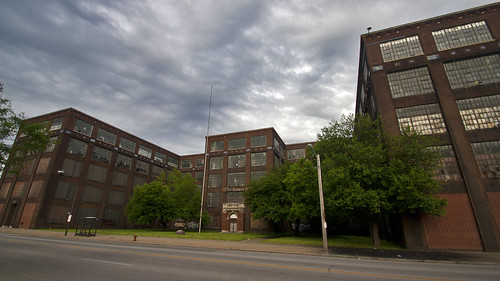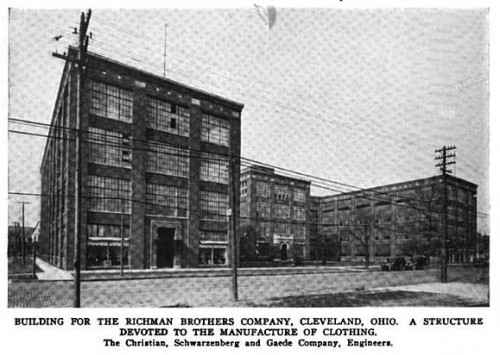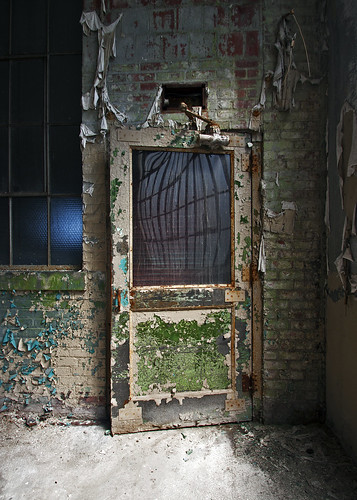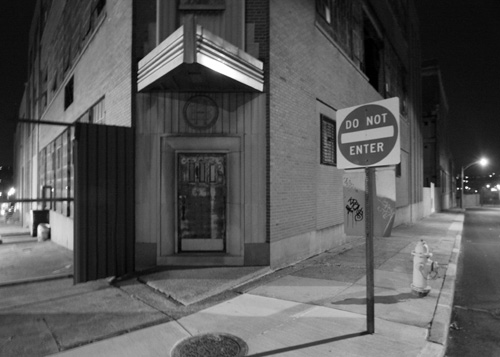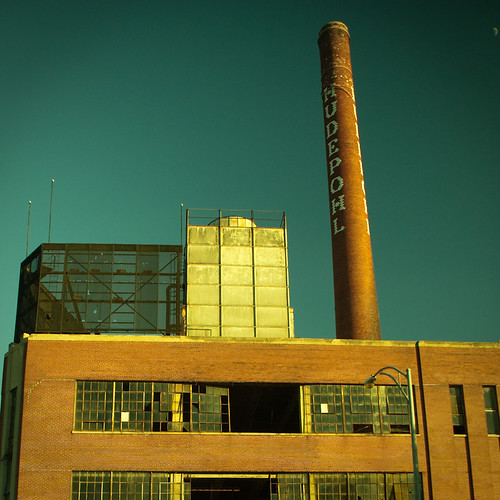
Photo: The Tyson emblem on the basketball court on the property.
Southington, Ohio is one of those places where everything a small American community needs is on one corner. The US Post Office, fire department, county clerk, church and convenience store are all within plain view of each other. When I pulled into Southington with an out of state license plate, one of the locals came by to greet me. Doug and I struck up a conversation and he told me all about Southington’s history as I ate lunch. In the 1970’s he and others from the area tried to set a Guinness World Record by playing basketball for 60 hours continuously. Graduates from the high school each receive $5 from a trust fund set up in the early 1900’s. Mike Tyson once owned a mansion not far up the road, too. I only pretended to be surprised about that last bit of information that Doug shared with me. In reality, the mansion is what I set out to see in the first place. After a solid 20 minutes of small talk I told him I was going to hike around Southington and snap some pictures.
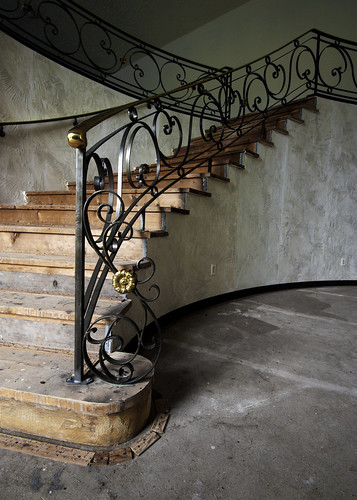
Photo: Staircase by the main entrance.
About a mile just north of the main intersection of the rural community is a large estate surrounded by overgrowth. An iron gate over the driveway bears the name of one of the most famous pugilists in history. Mike Tyson was a world champion boxer that electrified the sport. Within just three years of his professional debut at the age of 18 in 1985, Tyson’s career trajectory rocketed him to the top of the boxing world by 1988.
In 1980 Trumbull county commissioner Ted Vannelli helped himself to county funds to develop his home on an 50+ acre parcel of land in Southington. Authorities eventually caught wind of Vannelli’s impropriety and foreclosed on the mansion. Although the young boxer was flush with cash Tyson was able to purchase the Southington mansion for the rather thrifty sum of $300,000 at a sheriff auction. At the height of his boxing career, Tyson occupied the spacious home when training for fights at Don King’s facility in nearby Orwell.

Photo (source): The main living room of the gaudy mansion.
The luxurious mansion features five bedrooms, several spacious living quarters, seven and a half bathrooms, a full kitchen, a mini-kitchen/washroom, two attached garages, one external garage, full size pool and jacuzzi, tiger cages and basketball court. Tyson’s design choices included gold trim, zebra print carpet, and everything else you could imagine that was tacky for interior designs in 1989. Tyson would not enjoy his dwelling for too long before running afoul of the law.
Large sums of money, raw physical power, and a cast of shady characters surrounding the boxer may have been a corrupting influence. Tyson was taken into custody in 1991 on allegations of raping Desiree Washington in an Indianapolis hotel room. In 1992 a jury deliberated for ten hours before finding him guilty. The ruling committed Tyson to a six year prison sentence with four years of parole. In 1995 Tyson was granted parole and released from prison.
Tyson returned to the tranquil rural Southington community to find respite, but the media fanfare followed him. With his future boxing career in question and financial situation in dire straits Tyson puts the mansion on the real estate market. Four years later in 1999 a marketer named Paul Monea purchases the property for the sum of $1.3 million.

Photo: Living area next to the front door.
Monea isn’t a household name, but those who remember the Tae Bo fitness craze are familiar with his product. Undercover FBI agents set their sights on Monea when he tried sell the mansion along with the rare 43-carat yellow “Golden Eye” diamond in 2006. How Monea came into possession of the exquisitely rare diamond is not quite certain. What is certain, according to a Justice Department grand jury indictment filing, is that Monea and an accomplice conspired to conduct the transaction with drug dealers. Those drug dealers were in fact part of a cover story the FBI carefully crafted. For his crimes Monea was ordered to surrender the diamond, the mansion and $100,000. The Monea Family Trust tried to recover the diamond through legal means, but were subsequently denied in 2010. With all the other spurious ownership claims settled the government will auction off the exquisite Golden Eye diamond in September 2011.
Businessman Ron Hemelgarn placed the only bid when the mansion went up again in a sheriff auction on October 22, 2010. For $600,000 and $360,604.66 in back taxes Hemelgarn is now the legitimate owner of the former Tyson mansion. Because Hemelgarn originally held a $600,000 lien against the property at the time of sale, the money from the purchase price returns to him. The final figure means that Hemelgarn spent not much more than what Tyson did for the same property two decades earlier.

Photo: One of the few remaining furniture pieces. This one is quite elegant.
Not long after Hemelgarn took ownership he hired someone to do work on the property. Local authorities used to being summoned to the location for reports of trespassing must have been surprised to discover someone there legally. Within that timeframe Hemelgarn had much of the ugly furniture, horrendous carpet, and other home fixtures removed. Exposed carpet nails, a few ancient appliances, and heavier objects are all that remain behind. The bathrooms reek of foulness trapped by the lack of running water. A few miscreant explorers have found it necessary to mark their presence with spray paint. A throng of algae thrives at the lowest point of the mostly empty pool.
News of the nary occupied mansion first broke on the internet a few years ago after Monea was captured by the feds. Information from the site Illicit Ohio and photos Mike Adam’s Flickr set spread rapidly through internet content sources. Comparing my photos to that of explorers past, it is clear Hemelgarn is intent on doing something positive with the property. He may have a difficult time, however, breaking the stigma attached to the history of the property. Just like the Willis Tower in Chicago will always be the Sears Tower in the minds of a certain segment of the population, so too will this mansion be indelibly marked as the Tyson mansion despite whoever owns it.
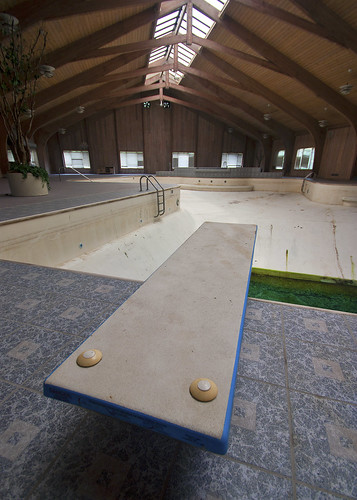
Photo: Diving board next to the massive indoor pool. Notice the green water.
There are few urbex locations that I visit that are actually rehabilitated after an extended dormant period. It is sad to see the Tyson mansion fall off the list of possible shooting locations for urban explorers. It is important though, that we appreciate a location for what it is in the time and space that it does exist.
When I set out to fundraise for this trip I set the Tyson mansion as a general goal in my head. I’m glad to report that the gamble to drive to a remote location with a minimal amount of location information was a success. Thanks again to all of you who made this possible. Thanks also, to the brave explorers in whose footsteps I travel.
Resources:
CantonRep – Article about the Golden Eye diamond.
Cleveland.com – The Golden Eye diamond will go up for auction in September.
Clevescene – Article about Monea’s shady business dealings.
Danny Wills – Gallery #1 and #2 of the decor within the mansion in August 2008.
FindLaw – US v. Monea Family Trust ruling in the 6th Circuit Court.
Flickr – Mike Adams excellent set of the mansion.
Flickr – My Mike Tyson Mansion set of photos.
Galivantin’ in Ohio – Timeline of the mansion history.
Illicit Ohio – Details of one urbex photographer’s journey and research on the mansion.
People Magazine – 1995 article mentions the Southington mansion.
Property Pursuit – Lists the real estate details for potential buyers.
Time – 1999 article that mentions Paul Monea in unflattering terms.
Trib Today – Police catch three trespassers on the property.
Trib Today – Ownership transferred to Ron Hamelgarn in 2010.
US District Court (PDF) – Indictment of Paul Monea that mentions the manson.
Wikipedia – Entry for boxer Mike Tyson.
WKBN – Police respond to reports of trespassing.
